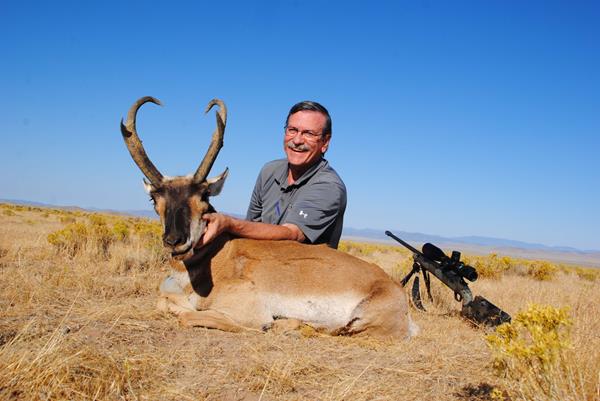
Long gone are the days of African safaris lasting more than a month, but this year’s hunt in Utah became something of a safari for me. With deserts, hills, mountains, and dry lakes, this desolate country is like much of Africa. For 14 years, I had applied as a non-resident for antelope. Non-resident tags are very few in this state, but they are especially over- subscribed in Utah’s best unit. When DOW changed the rules for non-resident applications some years ago, it became clear to me I wouldn’t live long enough to ensure a tag. After much deliberation, I applied for and was awarded a permit in what was considered Utah’s second best unit. After two days of thorough scouting before the season opened, I turned my tag back to the Division of Wildlife. The second best unit held no trophy antelope.
With age and opportunity working against me, I picked what I judged to be Utah’s next best unit and applied. It had produced a fine trophy 10 years ago and another good one in recent years. I was awarded one of the four coveted non- resident bonus permits in Utah’s Southwest Desert. My hunting buddy in Arizona agreed to drive me. He’s also an accomplished taxidermist. We arrived in Utah and began scouting that afternoon.
The unit is huge, about 125 miles north-south and 88 miles east-west, spread over three counties. Not exactly rectangular, but it surely must be 7,000 square miles. We drove every valley and every desert at least once, and where we saw antelope, we drove back again and again, stopping to glass every buck. Some days, we logged more than 400 miles, but sometimes we would look for six hours without seeing an antelope. Good quality antelope country was everywhere, but there were few herds. The day before the season opened, we saw a few trucks with hunters scouting. Opening morning, we passed many others.
They thinned out quickly, and on Sunday, we just about had the whole place to ourselves. One buck we liked and wanted to inspect further, we never saw again. Could he have been shot? I’ll never know. The trouble was, we simply weren’t seeing trophy quality bucks at the upper end of the scale. Where were they? We saw elk. We saw deer. We saw cows and wild horses, badgers and coyotes, eagles and dust devils, dry lakes and mirages, but few antelope. My trophy had to be somewhere.
Day after day, we drove hundreds of miles offroad, glassing every buck we encountered. We were on the highway before dawn and home after sunset every day, averaging over 300 miles each time we left the motel. After seven days, we were sure we’d seen everything, so it was time for me to pick the best knowing we’d done our best.
When it became clear there were no giants to shoot, I had to find the biggest one and take him. Late in the afternoon of the seventh day, I set my sight and the crosshairs of the Z5 5x25-56mm Swarovski tactical scope atop the .28 Nosler built by Ryan Pierce of Piercision Rifles, Inc. on a pretty little buck with perfectly proportioned horns. If not the biggest, he had the best configuration of any buck I’d seen. With Harris bipod and handloads of 195 grain Berger bullets leaving the muzzle at 3,050 fps, I knew I could kill the buck of my choice. However, he walked out of sight before I could shoot. I wasn’t too disappointed. Next year, he might be a real trophy for some lucky hunter. This year, I wanted something bigger.
And that’s exactly what I found the next morning, a buck with deeper hooks we hadn’t seen before. Evidently, we hadn’t seen everything. He held tight at 320 yards while I set up. One shot and he was down. I wish I could tell you it was a perfect one-shot kill, but it wasn’t. I felt solid in my rest and did not see the crosshairs move before I gently squeezed the trigger, but the bullet didn’t hit exactly where I aimed. He needed a second shot. My buddy reminded me that 99% of the time it’s the hunter who messes up and not the gun. He’s right, of course, but I wonder if it has something to do with me being a left-hander shooting a right-handed gun. That answer will require some work at the shooting range.
Scoring 81 7/8" in the SCI record book, I am proud of my one and only Utah antelope. I can’t apply again for three years, but I will. The number of applicants ensures I’ll never get a bonus tag again, but maybe I’ll draw a random tag. Then I’ll be back to look for something even better.
In eight days of scouting and hunting, with 2,500 miles of driving, we saw perhaps three dozen mature bucks and a couple dozen other hunters. In many respects, this is not a bad prescription for trophies. Arizona, for example, has fewer antelope compared to some states, but it also has a disproportionately large number of trophy bucks. That’s what we hoped for here. Eighty-eight antelope permits were allotted in this unit – resident and non-resident, rifle, archery, and muzzleloader. I doubt every tag was filled, but I hope the other hunters did well. Wide open, good antelope country is everywhere. This is as close to an African safari as I’ll ever get. Keep your eyes on the Southwest Desert of Utah. It holds great potential to become Utah’s next best trophy hot spot.